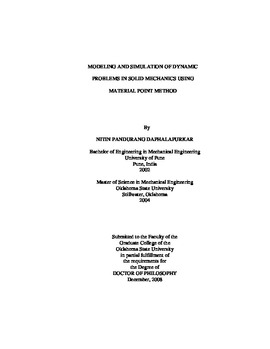| dc.contributor.advisor | Lu, Hongbing | |
| dc.contributor.author | Daphalapurkar, Nitin Pandurang | |
| dc.date.accessioned | 2013-12-10T18:05:15Z | |
| dc.date.available | 2013-12-10T18:05:15Z | |
| dc.date.issued | 2008-12 | |
| dc.identifier.uri | https://hdl.handle.net/11244/7792 | |
| dc.description.abstract | Scope and Method of Study: A relatively new computational method, namely Material Point Method (MPM), developed by Prof. Sulsky^1 of University of New Mexico , from the Particle-In-Cell (PIC) method in computational fluid mechanics, was used for simulations of dynamic problems. In this regard, various dynamic and material simulations have been carried out, which include dynamic crack growth using cohesive zone model, microstructure evolution of closed-cell polymer foam in compression and simulation of granular materials. In this process the MPM algorithm was developed by, either implementing completely newer capabilities of simulation or refining the older versions for increased robustness and versatility. | |
| dc.description.abstract | Findings and Conclusions: The incorporation of a characteristic length scale in MPM through cohesive zone model allowed investigation of physics-based dynamic crack propagation. The simulations are capable of handling crack growth with crack-tip velocities in both sub-Rayleigh and intersonic regimes. Crack initiation and propagation are the natural outcome of the simulations incorporating the cohesive zone model. Good qualitative agreement was observed between numerical results presented here and the experimental results in terms of the photoelastic stress patterns ahead of the crack-tip. | |
| dc.description.abstract | MPM will allow prediction of material properties for microstructures driving the optimization of processing and performance in foam materials through simulation of real microstructures. The simulations are able to capture the various stages of deformations in foam compression. The stress-strain curve simulated from MPM compares reasonably with the experimental results. Based on the results from µ-CT and MPM simulations, it was found that elastic buckling of cell-walls occur even in the elastic regime of compression. Within the elastic region, less than 35% of the cell-wall material carries majority of the compressive load. | |
| dc.description.abstract | The particle nature in MPM was found suitable for simulation of granular materials. Contact algorithm has been implemented in MPM to allow MPM to handle slip and friction between bodies in contact. Nanoindentation was carried out on sand grains to determine its properties at granular level, which can be used along with µ-CT to carry out granular simulations of sand. | |
| dc.format | application/pdf | |
| dc.language | en_US | |
| dc.rights | Copyright is held by the author who has granted the Oklahoma State University Library the non-exclusive right to share this material in its institutional repository. Contact Digital Library Services at lib-dls@okstate.edu or 405-744-9161 for the permission policy on the use, reproduction or distribution of this material. | |
| dc.title | Modeling and simulation of dynamic problems in solid mechanics using material point method | |
| dc.contributor.committeeMember | Komanduri, R. | |
| dc.contributor.committeeMember | Hanan, Jay C. | |
| dc.contributor.committeeMember | Bukkapatnam, Satish T. S. | |
| osu.filename | Daphalapurkar_okstate_0664D_10583.pdf | |
| osu.accesstype | Open Access | |
| dc.type.genre | Dissertation | |
| dc.type.material | Text | |
| dc.subject.keywords | closed-cell foam | |
| dc.subject.keywords | dynamic crack propagation | |
| dc.subject.keywords | generalized interpolation material point method | |
| dc.subject.keywords | material point meth | |
| thesis.degree.discipline | Mechanical and Aerospace Engineering | |
| thesis.degree.grantor | Oklahoma State University | |
